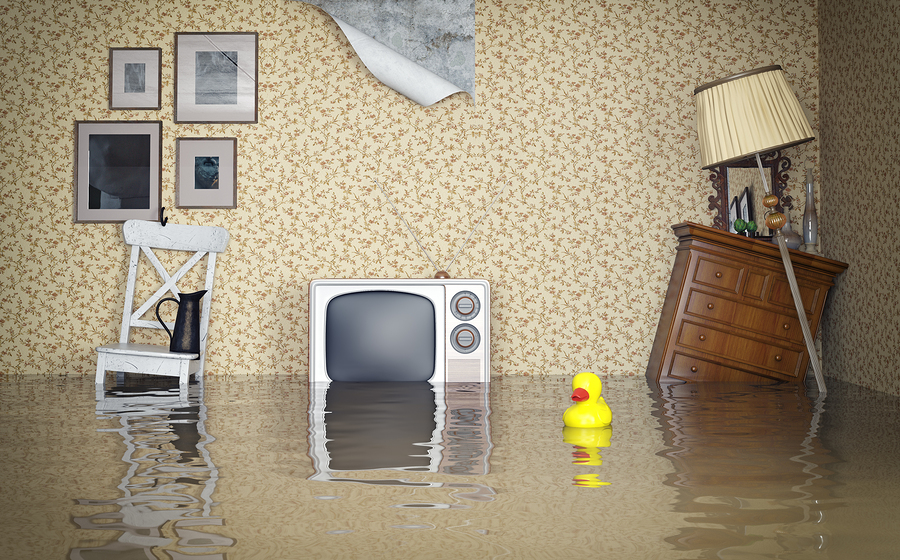Follow along to learn how to recognize the signs of a busted water pipe, the first things you need to do when a pipe bursts in your home, and how to prevent your pipes from freezing in the first place.
Signs of a Busted Water Pipe
Sometimes, a busted water pipe can show warning signs before serious damage occurs. Watch out for common symptoms of a pipe burst, which include:
- Fluctuating water pressure.
- Discolored, rusty water with a strange smell.
- Pipes making clanging noises behind walls.
- Your water bill suddenly spiking.
- Puddles forming under your sinks.
If you notice signs of a burst pipe, you must take action quickly to limit the damage that is done.
First Steps to Take When a Pipe Bursts

- Turn Off Your Water and Drain the Faucets
Turn off your home’s main water supply valve immediately. The sooner you can do this, the better your chances are of minimizing water damage. Your main water shut-off valve is likely located near your water meter.
This will limit the amount of water damage your home suffers. Every second count! Every person who lives in your home needs to know where the main water shutoff valve is located and how to turn it off and on, so they understand how to do so in the event of an emergency
Once the water has been shut off, you need to open your faucets to drain the remaining cold water in your pipes. This will relieve pressure in your pipe system and can help prevent additional areas from freezing. Then, flush all the toilets in the house. Once water is no longer running from the taps, any leaks should stop.
Depending on the location and size of the leak, you may also need to shut off your electricity. If you suspect the leaking water came into contact with any electrical sockets or your fuse box, this is an important precaution to take.

- Locate the Burst Pipe
Your next step should be to figure out where the pipe burst. If it appears to have been leaking for a while, be careful entering rooms and look for bulging ceilings and other warning signs that water damage has already occurred. If you catch the leak early enough, place a bucket underneath to catch dripping water.
Looking exactly where the pipe burst is should be done immediately to prevent further damage. If it’s a tiny crack, patching it up may fix the problem for a while. Also, consider which pipe has burst. If the damage is in the main water pipe, it needs to be repaired and dealt with carefully, regardless of the cause or size of the break.

- Call In Professional Help
As soon as possible, call in the experts to handle repairs. Hire a professional plumber to fix or replace your burst pipes, and if you have any damage to your electrical system, you should bring in a reliable electrician.
According to research in the US, the average homeowner spends between $1,000 and $4,000 on burst pipe repair and cleanup, though costs can vary based on location, the extent of the damage, and if emergency after-hours service is needed.
There’s just no substitute for an experienced professional. A licensed plumber will make reliable repairs, whereas an inexperienced homeowner or handyman may complete a repair that is inadequate and could soon fail. Besides, a professional plumber has liability insurance and if his repair fails, he is responsible for making it right. If you or an uninsured handyman make the repairs, you’re on your own if something goes wrong.

- Start Cleaning Up
If your house is flooded from a burst pipe, it’s important to dry the wet areas as quickly as possible. The longer water sits, the better chance there is for mold to grow and for more extensive, long-term damage to be done.
How to Clean Up After a Water Leak
Salvage Important Belongings
In the case of standing water in any room, you should quickly unplug any electronics before you start recovering important belongings. When salvaging items that have come in contact with water, prioritize things that are the most difficult to replace or the most expensive, such as important documents, family keepsakes, computers, and TVs.
Dry Any Wet Areas
Remove everything you can from the affected areas, including soaked carpets and furniture.
If you’ve shut off your power or standing water is shallow, you can use old towels, mops, and buckets to dry affected areas. If your house is flooded a few inches or more from the burst pipe, you’ll want to use a submersible pump or a wet/dry vac. These can be rented or bought from your local hardware store or Home Depot.
After standing water has been cleaned up, open windows (weather permitting) and sets up fans and space heaters to speed up the drying process.
In case you need verified artisans like a plumber, electrician or cleaner for your home, call to book an appointment on 020 005 4188. You can also visit Our website to book your appointment.

